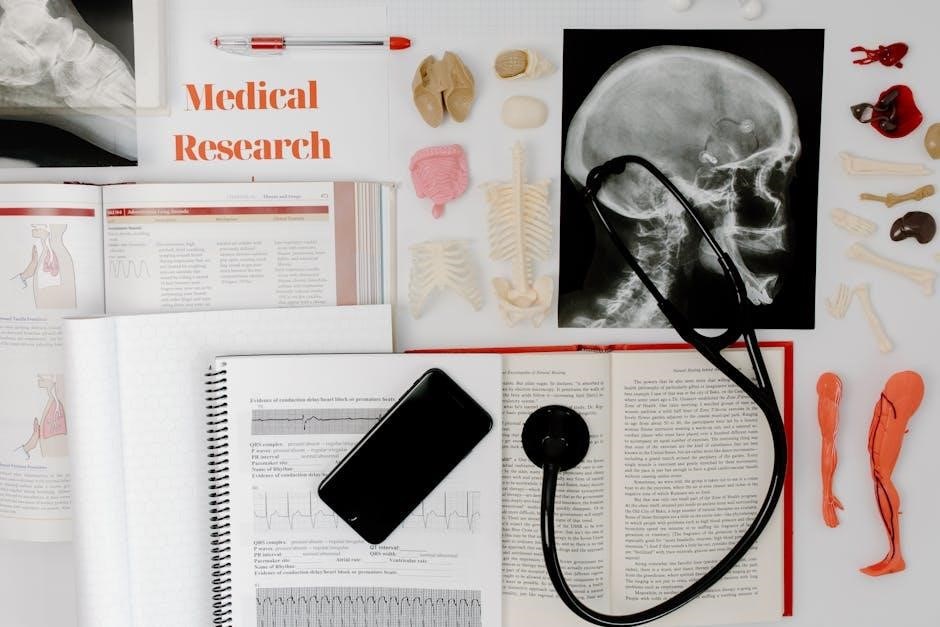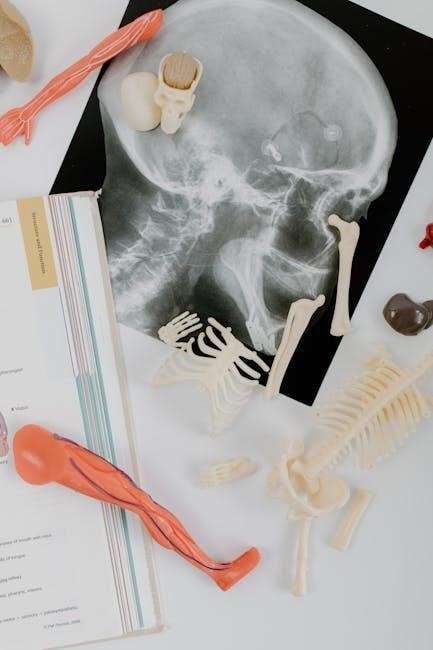The 7th Edition of Lehninger Principles of Biochemistry is a bestselling textbook known for its clarity and comprehensive coverage of biochemistry’s core principles, definitive discoveries, and cutting-edge advancements․
Overview of the Textbook
Lehninger Principles of Biochemistry, 7th Edition, authored by Michael M; Cox and David L․ Nelson, is a widely acclaimed textbook that provides a comprehensive understanding of biochemistry․ It is available in multiple formats, including PDF, hardcover, and loose-leaf, catering to diverse learning preferences․ The 7th edition is renowned for its clarity and coherence, making complex biochemical concepts accessible to students․ It features updated chapters on topics such as RNA editing, synthetic cells, and non-coding RNAs, ensuring students are well-versed in the latest advancements․ The textbook is a go-to resource for both undergraduate students and educators, offering a balanced mix of foundational principles and cutting-edge research․
Importance of Biochemistry in Modern Science
Biochemistry is integral to modern scientific progress, significantly influencing medicine, agriculture, and environmental science․ By elucidating life’s molecular processes, it enables the creation of life-saving drugs, personalized treatment plans, and advanced diagnostic techniques․ In agriculture, biochemical research leads to high-yield, disease-resistant crops and efficient fertilizers, crucial for sustaining a growing population․ Environmental scientists rely on biochemical principles to mitigate pollution and combat climate change․ Furthermore, biochemistry is the cornerstone of genetic engineering and biotechnology, driving innovation across various sectors․ Lehninger Principles of Biochemistry, 7th Edition serves as an essential resource, equipping students with the knowledge to engage with and advance these critical areas of science, ensuring future breakthroughs and fostering scientific literacy․
Authors and Their Contributions
The Lehninger Principles of Biochemistry, 7th Edition, is authored by David L․ Nelson and Michael M․ Cox, both renowned biochemists and educators․ Their expertise has been instrumental in shaping the textbook into a comprehensive and accessible resource for students and professionals․ Nelson’s contributions include clarifying complex biochemical concepts, while Cox has enhanced the integration of modern research findings․ Together, they ensure the text remains accurate, engaging, and aligned with cutting-edge discoveries․ Their collaborative effort has made the 7th edition a trusted reference, blending foundational knowledge with innovative insights to foster deeper understanding in the field of biochemistry․ Their work continues to inspire and educate a new generation of scientists and researchers globally․

Key Features of the 7th Edition
- Updated content reflecting recent biochemical discoveries․
- Enhanced visuals, including detailed diagrams and illustrations․
- Clinical case studies to apply concepts to real-world scenarios․
- Improved organization for better comprehension and retention․
- Incorporation of cutting-edge research in biochemistry․
New Chapters and Updates
The 7th edition of Lehninger Principles of Biochemistry introduces new chapters and significant updates to reflect the latest advancements in biochemistry․ These additions include expanded coverage of synthetic biology, emphasizing engineered biological systems and their applications․ A new chapter on RNA biology delves into RNA editing, non-coding RNAs, and the RNA recognition motif, highlighting their roles in gene regulation and disease․ These updates ensure students gain a modern understanding of biochemistry․ The content is tailored to address emerging topics while maintaining the book’s foundational strengths․ These revisions make the 7th edition a comprehensive and up-to-date resource for biochemistry students and researchers alike․
Improved Clarity and Coherence
The 7th edition of Lehninger Principles of Biochemistry places a strong emphasis on improving clarity and coherence, making complex biochemical concepts more accessible to students․ The authors have streamlined content, ensuring a logical flow of ideas and reducing redundancy․ Key topics, such as metabolic pathways and enzyme kinetics, are presented with clearer explanations and simplified language․ The integration of visual aids, including diagrams and figures, further enhances understanding․ This edition also features reorganized chapters to better align with how biochemistry is taught in modern classrooms․ These improvements make the textbook more user-friendly and engaging, allowing students to focus on mastering the subject rather than deciphering dense text․
Integration of Modern Discoveries
The 7th edition of Lehninger Principles of Biochemistry integrates cutting-edge research and modern discoveries to provide a contemporary perspective on biochemistry․ Recent advancements in CRISPR-Cas9 gene editing, synthetic biology, and metabolic engineering are thoroughly covered, offering students insights into the latest developments in the field․ The textbook incorporates findings on non-coding RNAs, epigenetics, and lipidomics, reflecting the dynamic nature of biochemistry․ These updates ensure that students are well-prepared to tackle emerging challenges in medicine, biotechnology, and environmental science․ By blending foundational concepts with modern breakthroughs, the 7th edition bridges the gap between classroom learning and real-world applications, making it a valuable resource for both students and instructors․ This integration underscores the relevance of biochemistry in addressing global health and technological advancements․

Structure and Organization of the Book
The 7th edition is divided into 28 logically sequenced chapters, starting with foundational topics like cellular structure and metabolism, progressing to advanced biochemical processes․ This clear organization ensures students build knowledge systematically, with each chapter reinforcing prior concepts․ The textbook is designed for ease of navigation, making it an ideal resource for both learning and reference․
Chapter Breakdown
The 7th edition of Lehninger Principles of Biochemistry is organized into 28 chapters, each focusing on specific biochemical topics․ Early chapters introduce foundational concepts such as cellular structure, chemical principles, and metabolic pathways․ Subsequent chapters delve into core areas like glycolysis, the citric acid cycle, and oxidative phosphorylation, ensuring a comprehensive understanding of energy metabolism․ Later sections explore advanced topics, including lipid metabolism, amino acid and nitrogen metabolism, and nucleotide metabolism․ The textbook also includes dedicated chapters on gene expression, signal transduction, and metabolic integration, providing a holistic view of biochemistry․ Each chapter is structured to build upon previous concepts, ensuring a logical and progressive learning experience․ This organization makes it an invaluable resource for both students and professionals․
Logical Flow of Topics
The 7th edition of Lehninger Principles of Biochemistry follows a clear and logical progression of topics, designed to build foundational knowledge before advancing to complex concepts․ The textbook begins with an introduction to the principles of biochemistry, including cellular structure, chemical foundations, and thermodynamics․ Subsequent chapters systematically explore metabolic pathways, starting with glycolysis and progressing through the citric acid cycle and oxidative phosphorylation․ The flow then extends to specialized topics like lipid metabolism, amino acid metabolism, and gene expression․ Each chapter logically connects to the next, ensuring a seamless transition between subjects․ This structured approach helps students grasp the interrelationships between biochemical processes, fostering a deeper understanding of the field․ The logical flow enhances the learning experience, making the textbook accessible and engaging for readers․
Visual Aids and Illustrations
The 7th edition of Lehninger Principles of Biochemistry excels in its use of visual aids and illustrations, which are meticulously designed to enhance understanding․ Detailed diagrams, flowcharts, and molecular structures are presented with clarity and precision, helping students visualize complex biochemical processes․ The textbook incorporates vibrant colors and consistent formatting to highlight key elements, such as reaction pathways and enzyme mechanisms․ Additionally, the digital version includes interactive illustrations and 3D molecular models, allowing for a deeper exploration of structures and reactions․ These visual tools are integrated seamlessly with the text, making abstract concepts more tangible and engaging for learners․ The emphasis on visual learning ensures that students can grasp and retain information effectively․

Major Updates in the 7th Edition

The 7th edition introduces cutting-edge topics like synthetic cell biology, RNA editing, and advances in non-coding RNAs, providing fresh insights into modern biochemical discoveries․
Synthetic Cells and Disease
The 7th edition delves into groundbreaking advancements in synthetic cell biology, offering insights into how synthetic cells are engineered to mimic natural cellular functions․ This section explores the potential of synthetic cells in understanding disease mechanisms, such as modeling complex disorders like cancer and neurodegenerative diseases․ By recreating cellular environments, researchers can test drug efficacy and study disease progression in controlled settings․ The text highlights the implications of synthetic cells for personalized medicine and regenerative therapies, emphasizing their role in advancing medical research․ Additionally, the edition integrates recent studies on synthetic cell applications, providing a comprehensive overview of their promise and challenges in combating human diseases․
RNA Editing and Its Implications
The 7th edition of Lehninger Principles of Biochemistry explores the emerging field of RNA editing, a post-transcriptional modification process that alters RNA sequences․ This mechanism allows for the diversification of protein products without changing the DNA blueprint․ The text highlights the role of enzymes like ADAR (adenosine deaminases acting on RNA) in editing RNA molecules, particularly in the brain and other tissues․ RNA editing has significant implications for understanding neurological disorders, cancer, and immune responses․ It also sheds light on the complexity of gene expression and its regulation․ The edition emphasizes how recent discoveries in RNA editing are reshaping our understanding of molecular biology and disease mechanisms, offering new avenues for therapeutic interventions․
Advances in Non-Coding RNAs
The 7th edition delves into groundbreaking discoveries in non-coding RNAs (ncRNAs), which play crucial roles in regulating gene expression․ These RNAs, including microRNAs (miRNAs), long non-coding RNAs (lncRNAs), and circular RNAs (circRNAs), do not code for proteins but influence cellular processes like differentiation, growth, and disease progression․ Recent research highlights their involvement in epigenetic regulation, chromatin remodeling, and post-transcriptional control․ The textbook explores how ncRNAs act as scaffolds, signals, or guides, interacting with proteins and other RNAs to modulate gene activity․ Advances in this field have opened new insights into cancer, neurodegenerative diseases, and metabolic disorders, offering potential therapeutic targets․ The edition emphasizes the dynamic and versatile roles of ncRNAs in cellular biology and their significance in understanding human health and disease․
The RNA Recognition Motif
The RNA Recognition Motif (RRM) is a structural domain found in proteins that mediate RNA-protein interactions․ This motif plays a critical role in recognizing and binding specific RNA sequences or structures․ In the 7th edition, the textbook highlights how the RRM domain facilitates essential biological processes, such as RNA splicing, translation regulation, and RNA stability․ The RRM typically consists of a alpha-helical and beta-sheet structure, allowing it to interact with RNA through hydrogen bonding and hydrophobic interactions․ Its versatility enables it to bind diverse RNA molecules, from messenger RNAs to non-coding RNAs․ The motif is particularly important in proteins involved in post-transcriptional gene regulation․ This section underscores the significance of RRM in cellular processes and its implications for understanding RNA-related diseases․
Availability and Formats
The 7th edition of Lehninger Principles of Biochemistry is available in multiple formats, including PDF, hardcover, and loose-leaf versions, ensuring accessibility for diverse learning preferences․

PDF Edition
The 7th edition of Lehninger Principles of Biochemistry is widely available in PDF format, offering a portable and accessible option for students and researchers․ This digital version allows readers to access the full content of the textbook on multiple devices, including laptops, tablets, and smartphones․ The PDF format ensures that the layout and visuals remain intact, providing a seamless reading experience․ It is particularly popular among students due to its convenience for note-taking and highlighting․ Additionally, the PDF edition is often more affordable than physical copies, making it a cost-effective choice․ Many online retailers and eBook platforms provide the PDF version, ensuring easy access for learners worldwide․ This format is also environmentally friendly, reducing the need for physical printing․

Hardcover and Loose-Leaf Versions
The 7th edition of Lehninger Principles of Biochemistry is available in both hardcover and loose-leaf formats, catering to different preferences and needs․ The hardcover version is a durable, long-lasting option ideal for libraries, instructors, and serious students who prefer a high-quality, bound textbook․ On the other hand, the loose-leaf version offers flexibility and portability, making it easier to carry individual chapters or sections․ This format is particularly popular among students who value convenience and lighter loads; Both versions maintain the same comprehensive content, with clear typography and vibrant visuals, ensuring an engaging learning experience․ The hardcover’s sturdy binding and the loose-leaf’s adaptability make them excellent choices for academic and professional use․
Digital Resources and Study Guides
The 7th edition of Lehninger Principles of Biochemistry is supported by an array of digital resources and study guides, enhancing the learning experience․ The PDF edition allows for easy access on digital devices, with features like searchable text and zoom capabilities․ Additionally, the textbook is accompanied by online study guides, including practice problems, interactive quizzes, and detailed solutions․ Platforms like SaplingPlus provide interactive simulations, video tutorials, and customizable study plans․ These resources help students grasp complex concepts and track their progress․ Furthermore, expert-verified solutions and homework help are available, ensuring students can review and understand challenging topics․ These digital tools make studying efficient and engaging, catering to diverse learning styles․

Study Resources and Supplements
The 7th edition offers comprehensive study resources, including interactive tools, practice problems, and expert-verified solutions․ The PDF edition is accessible on multiple devices, enhancing flexibility for learners․
SaplingPlus Platform
The SaplingPlus platform is a comprehensive online resource designed to enhance learning for students using Lehninger’s Principles of Biochemistry․ It offers interactive homework tools, guided solutions, and a wide range of practice questions to reinforce key concepts․ Students can access detailed explanations and visual simulations to better understand complex biochemical processes․ The platform also provides real-time feedback, allowing learners to track their progress and identify areas for improvement․ With its intuitive interface and robust features, SaplingPlus is an essential companion for mastering the 7th edition of Lehninger’s Biochemistry․ It is accessible online, ensuring convenience for students studying at their own pace․
Test Bank and Homework Help
The test bank for Lehninger’s Principles of Biochemistry 7th Edition is an extensive resource for instructors, offering a wide variety of multiple-choice and short-answer questions․ These questions are carefully designed to assess student understanding of key concepts and biochemical processes․ Additionally, the homework help feature provides students with guided solutions and step-by-step explanations for selected problems․ This tool is particularly useful for reinforcing problem-solving skills and clarifying difficult topics․ The integration of the test bank with the SaplingPlus platform ensures a seamless experience, allowing students to practice and review material effectively․ This combination of assessment and support makes it easier for learners to master the subject․
Expert-Verified Solutions
The 7th edition of Lehninger Principles of Biochemistry provides expert-verified solutions to help students master complex biochemical concepts․ These solutions are meticulously crafted by leading biochemistry educators and researchers, ensuring accuracy and clarity․ They cover a wide range of topics, from metabolic pathways to molecular biology, offering detailed explanations for both textbook problems and real-world applications․ The solutions are regularly updated to reflect the latest scientific advancements and are accessible through the SaplingPlus platform․ This resource is invaluable for students seeking to deepen their understanding and improve their problem-solving skills․ The expert-verified solutions are also available in downloadable formats, making them a convenient study aid for learners worldwide․

Reception and Reviews
The 7th edition of Lehninger Principles of Biochemistry has received widespread acclaim for its clarity, depth, and modern approach․ Students and educators praise its engaging presentation․
Bestseller Status for Introductory Biochemistry
The 7th edition of Lehninger Principles of Biochemistry has consistently ranked as a bestselling textbook in introductory biochemistry․ Its comprehensive coverage of core concepts, combined with modern research advancements, has solidified its reputation as a go-to resource for students and educators alike․ The book’s clear and engaging writing style, along with its well-organized chapters, has made it a favorite among undergraduates․ Its bestseller status is further bolstered by its accessibility, balancing depth with clarity to accommodate learners at all levels․ The inclusion of cutting-edge topics ensures relevance, making it a top choice for those seeking a reliable and up-to-date guide in biochemistry․
High Ratings and Student Feedback
The 7th edition of Lehninger Principles of Biochemistry has received overwhelmingly positive reviews, with high ratings across academic platforms․ Students and instructors alike praise its clarity, depth, and ability to balance complexity with accessibility․ Many appreciate the updated visuals and real-world applications, which enhance understanding and engagement․ Feedback highlights the textbook’s effectiveness in preparing students for exams and fostering a strong foundation in biochemistry․ While some find the material dense, the majority agree that the rewards outweigh the challenges․ The integration of modern research and interactive resources further enhances its appeal, making it a preferred choice for learners worldwide․ Its reputation as a trusted resource continues to grow with each edition․
Comparison with Previous Editions
The 7th edition of Lehninger Principles of Biochemistry builds upon the foundation of its predecessors while introducing significant improvements․ Compared to earlier editions, it offers enhanced clarity, updated content, and a more logical flow of topics․ The integration of modern discoveries, such as advances in RNA biology and synthetic cell research, sets it apart from previous versions․ Students and educators have noted that the 7th edition retains the core concepts that made earlier editions successful but presents them in a more engaging and accessible manner․ This balance of tradition and innovation makes it a valuable upgrade for both new learners and those familiar with earlier editions․

Additional Resources and Tools
The 7th edition offers various resources, including study guides, digital tools, and online forums, enhancing learning and accessibility for students and educators alike․
Online Communities and Forums
Online communities and forums provide valuable spaces for discussing the Lehninger Principles of Biochemistry 7th Edition PDF․ Platforms like Reddit, Stack Exchange, and ResearchGate host active discussions where students and educators share insights, clarify doubts, and exchange resources․ These forums often feature threads dedicated to the 7th edition, offering tips for mastering complex topics and accessing supplementary materials․ Additionally, many academic groups share links to the PDF version, making it easier for learners worldwide to access the textbook․ Engaging with these communities fosters collaboration and enhances understanding of biochemistry concepts․
ResearchGate and Academic References
ResearchGate is a premier platform for scholars and researchers to share and access academic resources, including the Lehninger Principles of Biochemistry 7th Edition PDF․ This platform is widely used for its extensive library of scientific publications and educational materials․ Users can find the 7th edition PDF through searches or by following academic references shared by experts․ The platform also features discussions and Q&A forums where researchers and students discuss biochemistry topics, often citing the textbook as a primary resource․ Its reputation as a trusted academic hub makes it a go-to destination for accessing high-quality educational content like the Lehninger PDF․ This accessibility enhances its value for learners worldwide․
Amazon and Biblio Listings
The Lehninger Principles of Biochemistry 7th Edition PDF is widely available on platforms like Amazon and Biblio, catering to students and researchers seeking digital or physical copies․ Amazon offers the PDF alongside paperback and hardcover versions, with customer reviews and ratings providing insights into its quality․ Biblio, a marketplace for used and rare books, also lists the PDF, often at competitive prices․ Both platforms ensure accessibility, allowing users to purchase or download the textbook conveniently․ Amazon’s global reach and Biblio’s focus on academia make them reliable sources for obtaining the 7th edition․ These listings highlight the textbook’s popularity and demand in the scientific community․
The 7th edition of Lehninger Principles of Biochemistry remains a cornerstone in biochemistry education, offering comprehensive insights and updated research․ It is an indispensable resource for students and professionals alike, ensuring a deep understanding of biochemical principles and their real-world applications․
Final Thoughts on the 7th Edition
The 7th edition of Lehninger Principles of Biochemistry stands as a definitive resource in biochemistry, blending foundational concepts with cutting-edge research․ Its clear explanations and modern updates make it indispensable for students and professionals․ The integration of topics like CRISPR, synthetic biology, and non-coding RNAs ensures relevance in today’s scientific landscape․ The PDF edition’s portability and accessibility have made it a favorite among learners, while the hardcover and loose-leaf options cater to diverse preferences․ With its logical organization and engaging visuals, this edition reinforces biochemistry’s central role in understanding life processes․ It remains a trusted guide for mastering the field, offering unparalleled depth and clarity․
Recommendations for Future Readers
For those considering the 7th edition of Lehninger Principles of Biochemistry, it is highly recommended for its comprehensive and updated perspective on biochemistry․ The textbook’s clear explanations and modern insights make it an excellent choice for both students and professionals․ Readers are encouraged to explore the new chapters on synthetic biology and RNA-related topics, as these areas are pivotal to current advancements․ The inclusion of visual aids and digital resources enhances learning, while the PDF edition offers convenience․ For optimal understanding, pair the textbook with the SaplingPlus platform for interactive exercises and expert-verified solutions․ This edition is a valuable investment for anyone seeking a deep understanding of biochemistry’s principles and applications․
